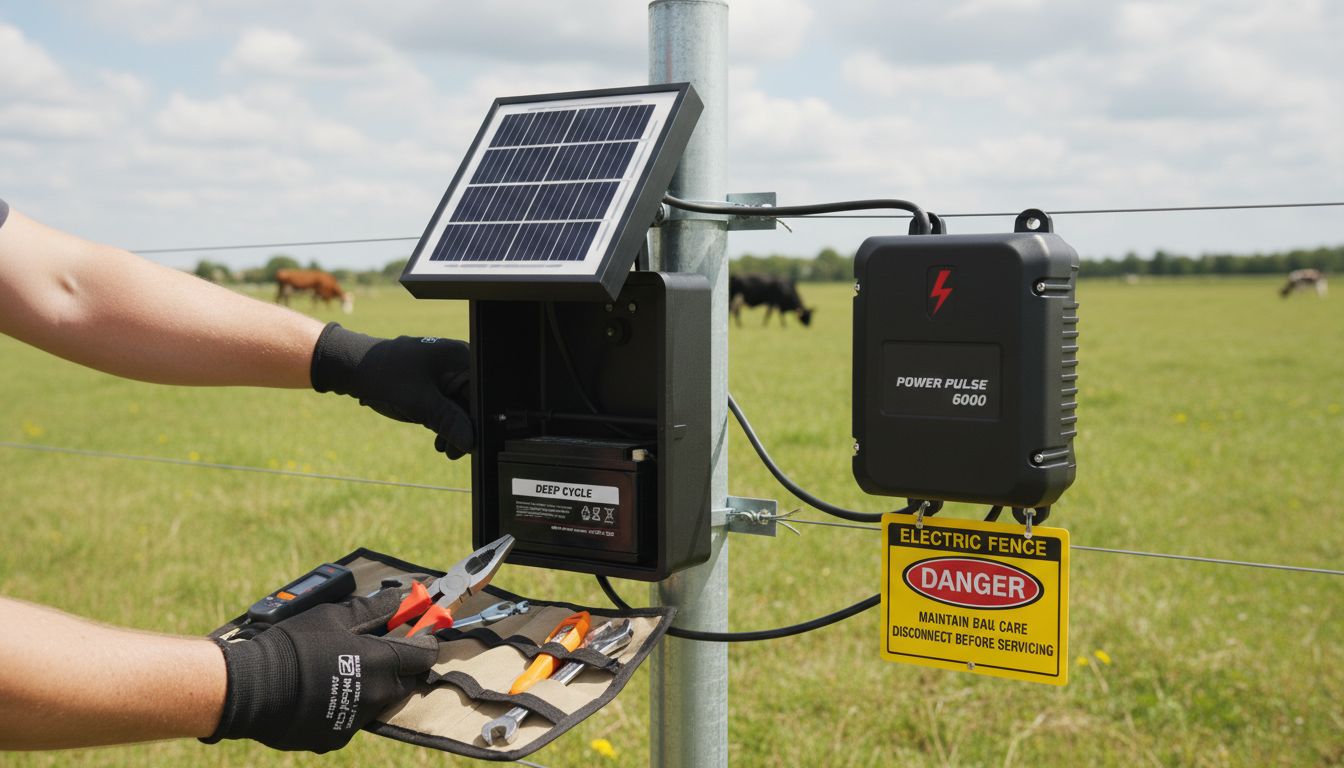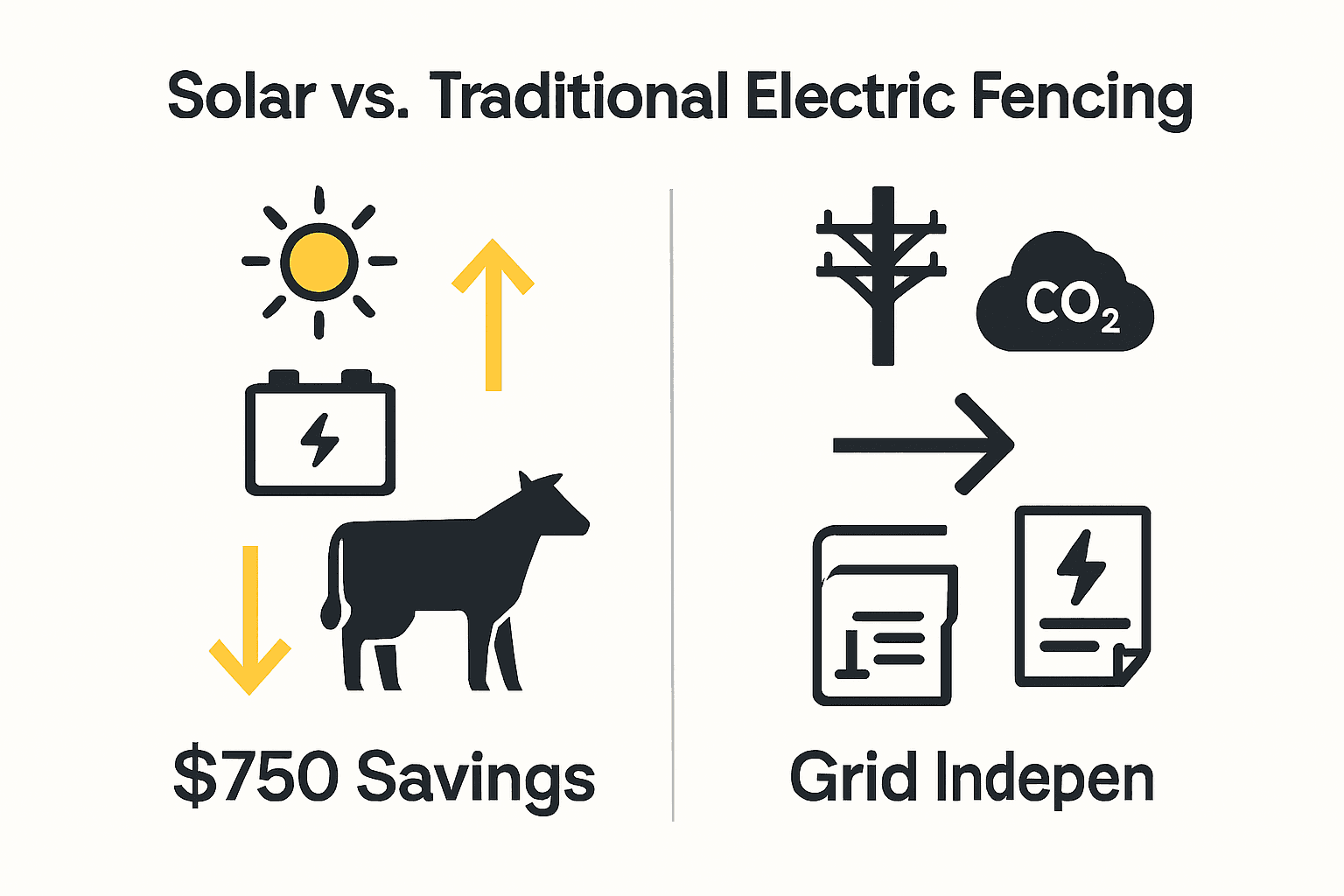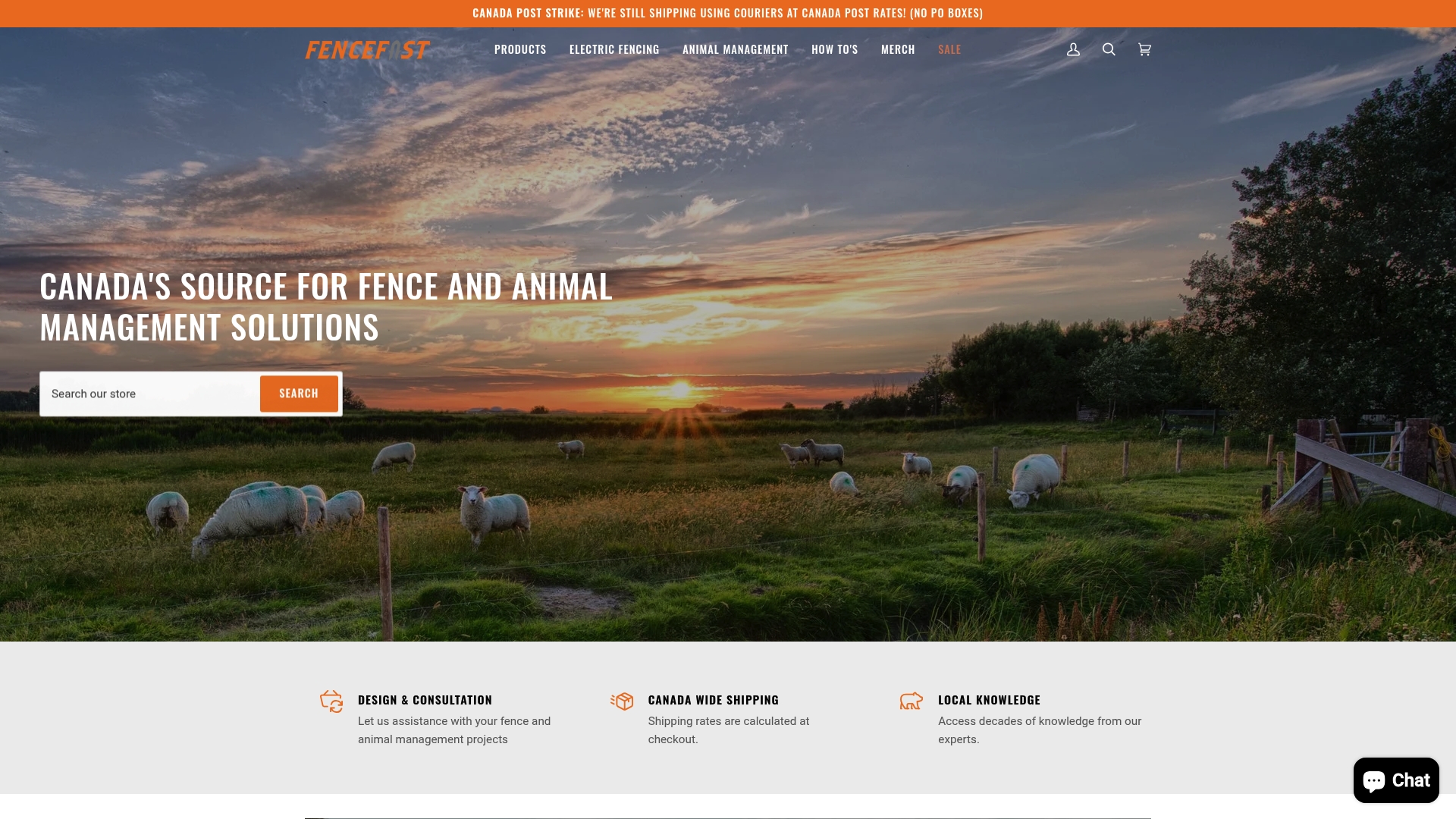Cattle farmers are turning to renewable energy for safer and more efficient herd management. Solar electric fences can operate for up to 14 days without sunlight, offering reliable protection even in unpredictable weather. These systems reduce greenhouse gas emissions and break free from grid dependency, making them a smart choice for remote properties. If you’re weighing options for keeping your livestock secure while cutting long-term costs, solar electric fencing delivers powerful solutions with a lighter environmental footprint.
Table of Contents
- Solar Electric Fences For Cattle Explained
- Major Types Of Solar Electric Fence Systems
- How Solar Fencing Works For Livestock Safety
- Installation And Maintenance Best Practices
- Common Challenges And How To Avoid Them
- Comparing Solar Electric Versus Traditional Fencing
Key Takeaways
| Point | Details |
|---|---|
| Sustainable Solution | Solar electric fences offer an eco-friendly alternative to traditional fencing by utilizing renewable energy sources, reducing overall greenhouse gas emissions. |
| Operational Benefits | These systems are grid-independent and can function effectively in remote areas, providing cost savings on electricity while minimizing operational complexities. |
| System Varieties | Solar electric fence systems include various types such as permanent, portable, hybrid, and remote monitoring solutions tailored to specific agricultural needs. |
| Maintenance Importance | Regular maintenance, including battery care and vegetation management, is crucial for ensuring optimal performance and longevity of the solar fence systems. |
Solar Electric Fences for Cattle Explained
Solar electric fences represent an innovative and sustainable solution for cattle management and property protection. According to Clean Energy Action Project, these systems utilize solar panels to convert sunlight into electricity, providing a reliable and environmentally friendly alternative to traditional electric fencing methods.
The core functionality of solar electric fences involves three primary components: solar panels, battery storage, and an electric fence energizer. As documented by Scitepress, the photovoltaic panels capture solar energy and convert it into electrical energy, which is then stored in batteries. This stored energy powers the fence’s energizer, which generates high-voltage pulses along the fence wire, creating an effective and humane animal barrier.
Key advantages of solar electric fences for cattle include:
- Grid Independence: Operates effectively in remote rural locations
- Cost Efficiency: Reduces long-term operational expenses
- Environmental Sustainability: Minimizes greenhouse gas emissions
- Versatility: Adaptable to various terrain and landscape configurations
Implementing a solar electric fence requires careful planning and understanding of your specific livestock and property needs. By leveraging solar technology, farmers can create robust, efficient perimeter management systems that protect cattle while embracing renewable energy solutions.
 Our guide on best solar electric fence chargers can help you select the most suitable equipment for your agricultural requirements.
Our guide on best solar electric fence chargers can help you select the most suitable equipment for your agricultural requirements.
Major Types of Solar Electric Fence Systems
Solar electric fence systems for cattle can be broadly classified into several distinct categories based on their design, power requirements, and operational capabilities. According to Scitepress, these systems primarily integrate solar energy with advanced monitoring technologies to create reliable and efficient security solutions for agricultural environments.
The main types of solar electric fence systems include:
- Permanent Grid-Connected Systems: Designed for long-term installations with consistent power supply and direct connection to existing electrical infrastructure
- Portable Off-Grid Systems: Ideal for temporary fencing or remote locations without electrical access
- Hybrid Solar-Battery Systems: Combine solar panel charging with backup battery storage for extended operation
- Remote Monitoring Systems: Advanced configurations with integrated sensors and digital tracking capabilities
Clean Energy Action Project highlights that some solar electric fence systems are engineered to operate efficiently for up to 14 days without direct sunlight, making them particularly valuable in regions with variable weather conditions. These systems typically incorporate robust components including solar panels, energy storage batteries, high-voltage energizers, and comprehensive grounding mechanisms.
Choosing the right solar electric fence system depends on your specific agricultural needs, terrain, and livestock management requirements. For comprehensive guidance on selecting the most appropriate portable solar fence energizer, farmers should consider factors such as property size, animal type, and local environmental conditions.
How Solar Fencing Works for Livestock Safety
Solar electric fencing represents a sophisticated and humane approach to livestock management and property protection. Clean Energy Action Project explains that these systems enhance livestock safety by delivering a brief, high-voltage pulse when an animal contacts the fence, creating a psychological and physical barrier that prevents animals from crossing without causing permanent harm.
The core mechanism of solar fencing involves a carefully engineered process:
- Solar Panel Capture: Photovoltaic panels convert sunlight into electrical energy
- Battery Storage: Collected energy is stored in robust rechargeable batteries
- Energizer Conversion: Stored energy is transformed into controlled high-voltage pulses
- Fence Wire Transmission: Pulses travel along fence wires, creating an effective deterrent
According to Scitepress, the system’s design ensures that when an animal or potential intruder touches the fence, they receive a brief but impactful shock. This shock is strategically calibrated to be uncomfortable enough to discourage future attempts at crossing, while remaining safe and humane. The technology is particularly valuable in remote areas without reliable electrical infrastructure, offering farmers a dependable solution for installing and maintaining a fence energizer solar system.
The effectiveness of solar electric fencing lies in its ability to create a psychological barrier. Livestock quickly learn to respect the fence’s boundaries, reducing the need for physical restraints and minimizing stress on the animals. By combining advanced solar technology with intelligent design, farmers can create secure, efficient, and environmentally friendly livestock management systems that protect both the animals and the property.
Installation and Maintenance Best Practices
Solar electric fence systems demand meticulous installation and ongoing maintenance to ensure optimal performance and longevity. Agritech highlights critical best practices that farmers must follow to maximize the reliability and effectiveness of their solar fencing systems.
Key maintenance considerations include:
- Battery Care: Monitor specific gravity and electrolyte levels
- Component Protection: Disconnect energizer during heavy storms
- Vegetation Management: Regularly clear fence line of growth
- Terminal Maintenance: Keep battery terminals clean and connections tight
- Positioning: Place batteries on wooden planks and maintain upright position
American Cattlemen emphasizes the importance of strategic component selection and environmental adaptation. This involves applying weather-resistant coatings, utilizing UV-resistant materials, and carefully positioning solar panels to maximize sunlight exposure. Farmers should also regularly assess their system’s performance against local weather conditions, ensuring the complete guide to portable solar electric fences aligns with their specific agricultural requirements.
Successful solar electric fence management goes beyond routine maintenance. It requires a holistic approach that combines technical understanding, proactive monitoring, and adaptive strategies. By investing time in regular inspections, cleaning, and component optimization, farmers can create a robust livestock containment system that delivers consistent performance, minimizes unexpected failures, and provides long-term value for their agricultural operations.
Common Challenges and How to Avoid Them
Solar electric fencing, while innovative, presents unique challenges that require strategic management and proactive planning. American Cattlemen highlights the critical importance of understanding and mitigating potential system vulnerabilities to maintain consistent livestock protection.
Major challenges and their prevention strategies include:
-
Weather Dependency: Reduced efficiency during prolonged cloudy periods
- Solution: Install additional battery storage capacity
- Use high-efficiency solar panels with wider charging ranges
-
Vegetation Interference: Growth can compromise fence conductivity
- Solution: Regular fence line clearing
- Implement mechanical or chemical vegetation management
-
Battery Degradation: Performance decline over time
- Solution: Quarterly battery health checks
- Replace batteries every 3-5 years
-
Lightning/Storm Damage: Potential system disruption
- Solution: Install surge protectors
- Disconnect energizer during severe weather events
Agritech recommends additional protective measures such as applying petroleum jelly to battery terminals, maintaining clean connections, and ensuring proper battery positioning. For farmers seeking comprehensive guidance, the complete guide to portable solar electric fences offers in-depth troubleshooting and maintenance insights.
Successful solar electric fence management transcends reactive problem-solving. It demands a holistic approach combining technical knowledge, consistent monitoring, and adaptive strategies. By anticipating potential challenges and implementing preventative maintenance, farmers can create resilient livestock management systems that deliver reliable performance across varying environmental conditions.
Comparing Solar Electric Versus Traditional Fencing
Farmers face a critical decision when selecting livestock fencing solutions, and solar electric fences offer compelling advantages over traditional alternatives. Clean Energy Action Project reveals that solar electric fences not only reduce greenhouse gas emissions but also provide significant long-term economic benefits.
Key comparative aspects include:

-
Environmental Impact
- Solar: Zero direct emissions
- Traditional: Approximately 1.4 pounds of CO2 emissions daily
-
Cost Efficiency
- Solar: Potential savings of $750 over five years
- Traditional: Continuous electricity expenses
-
Operational Flexibility
- Solar: Operates up to 14 days without direct sunlight
- Traditional: Constant grid dependence
-
Installation Complexity
- Solar: Modular and adaptable
- Traditional: Requires extensive electrical infrastructure
American Cattlemen emphasizes that while solar electric fences offer remarkable advantages, they are not without limitations. Weather sensitivity can impact performance, potentially causing temporary functionality reductions during prolonged cloudy periods. Farmers interested in detailed equipment selection can reference our guide on best solar fence energizers to make informed decisions.
Ultimately, solar electric fencing represents a forward-thinking solution that balances technological innovation, environmental responsibility, and practical agricultural needs. By understanding the nuanced differences between solar and traditional fencing, farmers can implement livestock management systems that are not just effective, but also economically and environmentally intelligent.
Secure Your Cattle with Reliable Solar Electric Fence Solutions Today
Managing livestock safely and efficiently often means overcoming challenges such as ensuring uninterrupted power supply and reducing long-term costs. This article highlights important issues like battery maintenance, weather dependency, and the need for adaptable, sustainable fencing systems. If you want to protect your cattle with the latest solar electric fencing technology that works even in remote areas, you need trusted tools designed for Canadian rural conditions.

Take control of your livestock management by exploring our comprehensive range of solar electric fence supplies, including energizers, batteries, and solar panels. At FenceFast.ca, you will find everything you need backed by expert advice to build a robust, eco-friendly fence system. Start improving your farm’s safety and efficiency now by visiting our complete guide to portable solar electric fences and discover the best products tailored to your needs. Don’t wait for costly downtime or equipment failure – secure your fence today and experience peace of mind.
Frequently Asked Questions
What are the main components of a solar electric fence for cattle?
A solar electric fence typically consists of solar panels, battery storage, and an electric fence energizer. The panels convert sunlight into electricity, which is stored in batteries and used to power the energizer, generating high-voltage pulses along the fence wire.
How does solar electric fencing enhance livestock safety?
Solar electric fencing delivers a brief, high-voltage pulse when an animal contacts the fence. This creates a psychological and physical barrier that discourages animals from crossing without causing permanent harm.
What are some advantages of using solar electric fences compared to traditional fences?
Solar electric fences offer grid independence, cost efficiency through reduced operational expenses, environmental sustainability with zero emissions, and versatility in installation across various terrains.
How often should I perform maintenance on a solar electric fence system?
Regular maintenance should include quarterly battery health checks, cleaning battery terminals, monitoring for vegetation interference, and clearing the fence line to ensure optimal performance and longevity.
